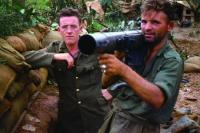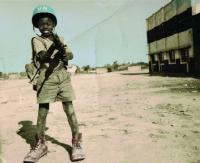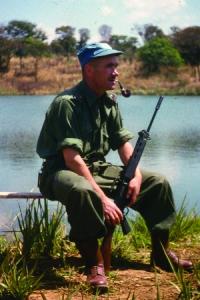Film eye: Congo—an Irish affair AkaJava Films by Eoin Dillon
Published in 20th-century / Contemporary History, General, Issue 3 (May/June 2011), Reviews, Volume 19
Irish UN troops of 35th Battalion’s A Company in action during their 1961 tour of Katanga. By September they found themselves under siege at Jadotville and surrendered after nearly a week of fierce fighting. (Leo Quinlan)
Among the audience at the screening were a spattering of men, now in their sixties and early seventies, many accompanied by family members, who were there to see a film version of events in which they had participated 50 years previously. They did not have the appearance of battle-hardened veterans; rather they were slightly older, still-fit men who were enjoying meeting old comrades, which they did with a certain old world courtesy. It was difficult not to think that many had joined the Irish army with two basic principles somewhere at the back of their minds: neither to kill nor be killed. They were present to see Congo—an Irish affair, a full-length documentary on the Irish army mission to the Congo in the immediate aftermath of its independence. It was part of the largest UN mission yet undertaken, involving 30 countries, and it was the first time Irish troops had served outside Ireland—a breaking out from the quarantine southern Ireland had been placed in during the 1950s, an engagement with a much larger, more complex world. Early on in the film, there is newsreel footage of African women dancing, some traditionally dressed, with a plummy voiceover intoning cheerily that ‘everybody was out and dressed in their very best. Indeed, they couldn’t wait to start the jubilation . . . Anyway, the people put on a good show.’ This is allowed to stand for the general feeling of optimism that did pervade much of sub-Saharan Africa during the first phase of independence during the late 1950s and early 1960s.But Congolese Independence Day, 30 June 1960, was a gloomy, sullen affair, full of political disunity, mass discontent, international uncertainty and a certain foreboding. Within two weeks of proclaiming independence the new prime minister, Patrice Lumumba, faced a countrywide mutiny by the army and a secessionist movement in the mineral-rich province of Katanga, backed by a combination of Belgians, who had intervened militarily on 10 July, and western mining interests, and led by an African, Moishe Tshombe.

Join the army; wear the boots! This picture of A Company’s mascot was taken by the cook, Cpl Bobby Allen.
Lumumba appealed successfully to the United Nations Security Council to send a UN peacekeeping force, in the hope of getting rid of Belgian troops and white mercenaries, thus putting an end to the Katanga secession. It was in this context that Irish troops were deployed to the Congo. All of this is covered in the opening minutes of the film. It was the first phase of a crisis that would end for the Congolese with a military coup in November 1965: the assassination of Lumumba, the end of the Katanga secession, a military dictatorship in place, and US, British and Belgian interests safeguarded. This film goes straight into the action: jeeps speeding through African streets, guns rattling, jets roaring overhead, politicians making statements. This is a film that relies very effectively on pace to draw the story on. No ‘back story’ is provided: the rape of the Congo, first as the personal fiefdom of Leopold, king of the Belgians, and later by the concessionary companies; a demographic crisis that in places saw 50% of the population wiped out; and the complete failure of the Belgians to prepare the Congo in any way for independence.

Cmmdt Patrick Quinlan, commander of the 35th Battalion’s A Company at Jadotville. One of the themes running through the film is the relationship with his men. (Leo Quinlan)
In seeking to find a genre within which this film may be classified as history, the category of labour history comes to mind—an account of Irish men working abroad to achieve certain objectives. These may be summarised, in the words of Minister of External Affairs Frank Aiken, as ‘the Congolese people getting a chance . . . they should be allowed to find their own feet and people shouldn’t make trouble for them’. In the context of what would follow, this may seem either naive or disingenuous, but it is an accurate summary of Irish public opinion at the time.High politics is covered: the appointment of Seán MacEoin as overall commander of the entire operation; the appointment of Conor Cruise O’Brien as UN special representative to the Congo, and his role in seeking to remove Tshombe; and the death of United Nations secretary-general Dag Hammarskjöld in an air crash. But their story has been told elsewhere, not least by O’Brien himself. The more interesting testimony is from recently taken interviews with men who served, in particular with A Company of the 35th Battalion at Jadotville, where they came under attack from Belgian-officered gendarmerie backing secession. Rather than the overall Irish operation in the Congo, the film concentrates on this particular incident, when A Company were under siege for a week before being taken prisoner. These were inexperienced men; most had never been out of the country, let alone on a plane before. They were under the command of Cmmdt Patrick Quinlan, and one of the themes running through the film is the relationship between him and his men. Some swore by him; at least one is somewhat dubious, though there may have been a personal element to this. Testimony from his son and letters he wrote home give his side of the story. A near success during the siege, with a ceasefire between both sides, turned against the Irish as their supplies ran out and relief failed to make its way through. Quinlan was forced to surrender—or face large-scale casualties. He did so without higher authority. His primary purpose was to ensure that none of the men under his command were killed. They were later released under a prisoner exchange deal. But, according to one interviewee, the men were not accorded the respect they were due when they rejoined the body of the 35th Battalion in the Katangese capital. Recommendations for commendations by Quinlan when they returned to Ireland were ignored. Jadotville went unremarked. Congo—an Irish affair uses fast, close editing of newsreel, interviews and narrative to create a gripping film that gives a voice to men—some officers, but mainly from the ranks—whose voices are rarely heard. When Irish troops first got involved in the Congo, they were seen as playing an essentially anti-colonial role: opposing metropolitan capitalist interests in favour of an emerging African nation. Conor Cruise O’Brien was prepared to use military force to oppose British interests. Since then, many African states have ceded control of their economic affairs to the International Monetary Fund. So, recently, has Ireland. HI
Eoin Dillon is a scholar of twentieth-century African history.
















